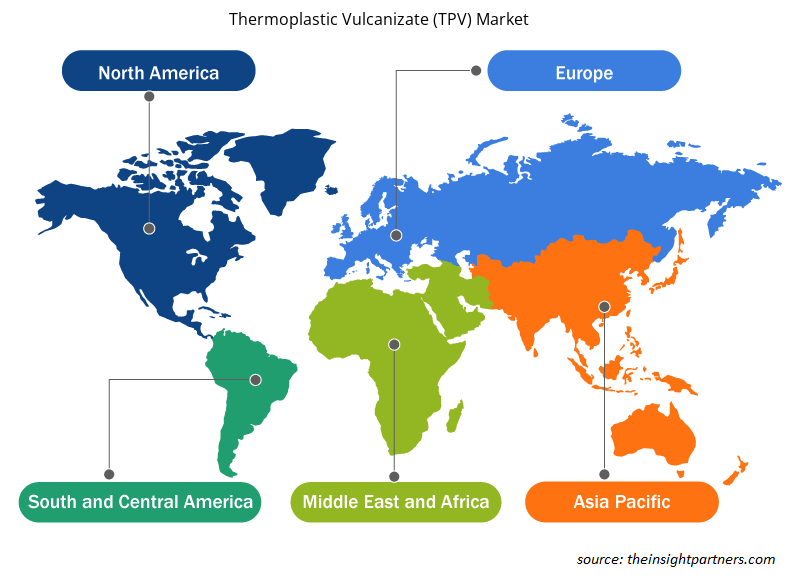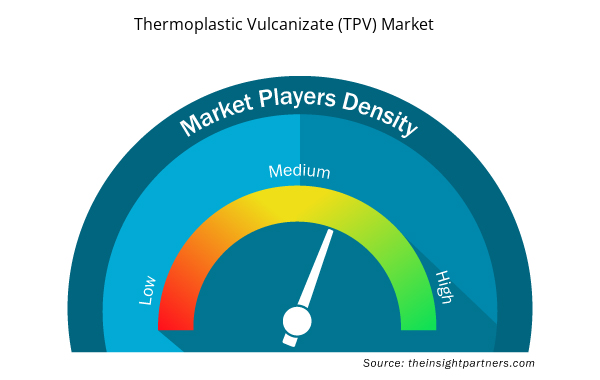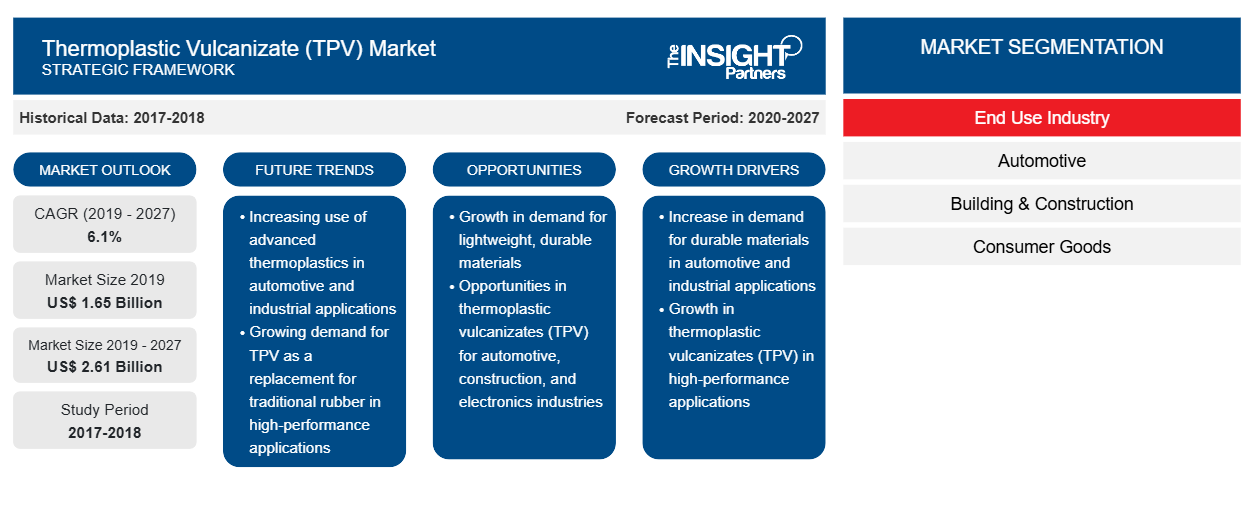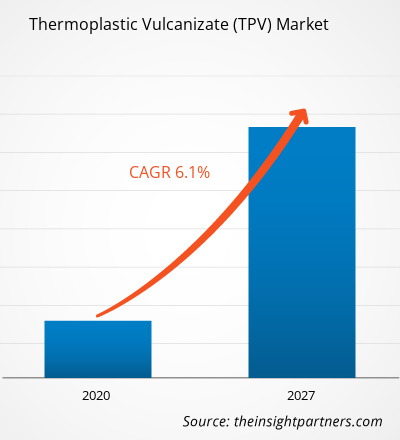Der Markt für thermoplastische Vulkanisate (TPV) wurde im Jahr 2019 auf 1.646,78 Millionen US-Dollar geschätzt und soll bis 2027 2.612,50 Millionen US-Dollar erreichen; im Prognosezeitraum dürfte er mit einer durchschnittlichen jährlichen Wachstumsrate von 6,1 % wachsen.
Thermoplastische Vulkanisate werden in einer Vielzahl von Produkten wie Waschmaschinen und Trocknern, Geschirrspülern, Kleingeräten, Griffen und Dichtungen sowie Kühlschränken für starre Teile und Dichtungen verwendet. Die Nachfrage nach thermoplastischen Vulkanisaten im Konsumgütersektor wird voraussichtlich steigen, da sie als leichte, vielseitige und weiche Materialien in verschiedenen Anwendungsbereichen wie Kleidung, Haushaltsgeräten, Körperpflegeprodukten, Küchengeschirr und Elektrowerkzeugen eingesetzt werden können. Darüber hinaus wird erwartet, dass sich das Wachstum der Konsumgüterindustrie in den BRIC-Staaten positiv auf den Markt für thermoplastische Vulkanisate auswirkt. Thermoplastische Vulkanisationen (TPVs) bieten hervorragende Effizienz, reduzierte Systemkosten und potenzielle Nachhaltigkeit. Aufgrund dieser Vorteile werden TPVs in der Konsumgüterindustrie verwendet. Beispielsweise produziert ExxonMobil Chemical thermoplastische Vulkanisate (TPVs) mit Hochleistungselastomeren, die Vielseitigkeit in der Produktion, einfache Verarbeitung und Haltbarkeit bieten. Durch die Bereitstellung einer überlegenen und konsistenten Leistung in industriellen und anspruchsvollen Verbraucheranwendungen bietet TPV das Potenzial für niedrigere Gerätekosten, reduziertes Gewicht und Recyclingfähigkeit im Vergleich zu Materialien wie EPDM (Ethylen-Propylen-Dien-Polymethylen-Rückgrat) oder anderen duroplastischen Kautschuken.
Nordamerika wird im Prognosezeitraum voraussichtlich den größten Anteil am globalen Markt für thermoplastische Vulkanisate (TPV) halten. Mehrere in- und ausländische Unternehmen haben in der nordamerikanischen Region eine starke Position. Das Wachstum des Marktes für thermoplastische Vulkanisate (TPV) in dieser Region ist in erster Linie auf die steigende Nachfrage nach Leichtbaumaterialien für die Herstellung verschiedener Autokomponenten zurückzuführen. Darüber hinaus dürften günstige staatliche Vorschriften für den TPV-Verbrauch in Automobilanwendungen als Alternative zu Legierungen und Metallen sowie die steigende Pkw-Produktion in den USA und Mexiko das regionale Marktwachstum im Prognosezeitraum weiter ankurbeln. Darüber hinaus haben technische Entwicklungen und die wachsende Nachfrage nach Elektrofahrzeugen den Bedarf an leichten, robusten und recycelbaren Gütern erhöht, was wiederum das Marktwachstum vorangetrieben hat.
Die USA, Indien, Brasilien, Russland, Frankreich, Großbritannien, die Türkei, Italien und Spanien gehören zu den am stärksten betroffenen Ländern in Bezug auf bestätigte Fälle und gemeldete Todesfälle aufgrund von COVID-19 (Stand: Dezember 2020). Laut den WHO-Daten vom Dezember 2020 wurden weltweit ~80.453.105 bestätigte Fälle und 1.775.776 Todesfälle gemeldet. Die COVID-19-Pandemie hat die Volkswirtschaften durch Lockdowns, Reiseverbote und Betriebsschließungen beeinträchtigt. Die globale Chemie- und Materialindustrie ist eines der größten Unternehmen, die aufgrund dieser Einschränkungen Lieferkettenunterbrechungen und Produktionsunterbrechungen erleiden. China ist das globale Zentrum der Produktion und der größte Rohstofflieferant für verschiedene Branchen. Die Schließung verschiedener Werke und Fabriken in führenden Regionen wie dem asiatisch-pazifischen Raum und Europa beeinträchtigt die globalen Lieferketten und wirkt sich negativ auf die Produktion, Lieferpläne und Produktverkäufe aus. Diese Faktoren haben sich negativ auf das Wachstum des globalen Marktes für thermoplastische Vulkanisate (TPV) ausgewirkt.
Passen Sie diesen Bericht Ihren Anforderungen an
Sie erhalten kostenlose Anpassungen an jedem Bericht, einschließlich Teilen dieses Berichts oder einer Analyse auf Länderebene, eines Excel-Datenpakets sowie tolle Angebote und Rabatte für Start-ups und Universitäten.
- Holen Sie sich die wichtigsten Markttrends aus diesem Bericht.Dieses KOSTENLOSE Beispiel umfasst eine Datenanalyse von Markttrends bis hin zu Schätzungen und Prognosen.
Markteinblicke
Verwendung von biobasiertem thermoplastischem Vulkanisat
Um die Abhängigkeit von nicht erneuerbaren Ressourcen wie Erdöl zu minimieren und eine nachhaltige Entwicklung der Polymerwerkstoffindustrie zu erreichen, bevorzugen viele Menschen biobasierte Polymerwerkstoffe. Biobasierte thermoplastische Vulkanisate (TPV) bestehen aus Poly(lactid) (PLA) und Ethylen-co-Vinylacetat-Kautschuk (EVA), die unter Verwendung von Dicumylperoxid (DCP) als Härtemittel hergestellt wurden. Dies ist das erste Mal, dass die Anwendung von PLA in elastischen Materialien demonstriert wurde. Da biobasierte TPVs wenig Kohlenstoffemissionen aufweisen und biologisch abbaubar sind, wird ihre Synthese in den meisten Ländern gefördert. Sie gelten derzeit als nachhaltige Alternativen zu herkömmlichen erdölbasierten Polymeren, da sie aus erneuerbaren Ressourcen wie stärkebasierten Polymeren, Polylactiden (PLAs), Polyhydroxyalkanoaten (PHAs), cellulosebasierten Polymeren und sojabasierten Polymeren gewonnen werden. Da biobasierte TPE nicht nur eine saubere Lösung darstellen, sondern den Herstellern biobasierter TPE gegenüber ihren synthetischen Pendants auch eine preisliche Wettbewerbsfähigkeit bieten, dürften sie erhebliche Marktwachstumsmöglichkeiten schaffen.
Einblicke in die Endverbrauchsbranche
Basierend auf der Endverbrauchsbranche ist der Markt für thermoplastische Vulkanisate (TPV) in die Bereiche Automobil, Bauwesen, Konsumgüter, Gesundheitswesen und andere unterteilt. Im Jahr 2019 dominierte das Automobilsegment den Markt. Leichtbaumaterialien für Automobile haben in den letzten Jahren aufgrund der wachsenden Nachfrage nach luxuriösen, emissionsarmen, sicheren und leistungsstarken Fahrzeugen ein starkes Wachstum erlebt. Infolgedessen haben Lieferanten und Hersteller eine Reihe von Lösungen auf den Markt gebracht, die OEMs nicht nur dabei helfen, strenge Vorschriften einzuhalten, sondern auch die wachsende Bandbreite persönlicher Kundenanforderungen erfüllen. TPVs sind auch eine sinnvolle Alternative zu teuren Elastomeren. Sie bieten eine hervorragende elastomere Haltbarkeit, einschließlich relativ hoher Zugfestigkeit und Bruchdehnung, hoher elastischer Rückbildung sowie guter Dimensionsstabilität in heißer Luft und ausgezeichneter Beständigkeit gegen UV-Alterung, Ozon und Witterungseinflüsse. Die wichtigsten Anwendungen von TVP in der Automobilindustrie umfassen Schlauchabdeckungen, Lufteinlasskanalabdeckungen, Dichtungen, Dichtungen, Faltenbälge, Schwingungsdämpfer, Federbeinabdeckungen, Zündteile, Buchsen und Fensterdichtungen. Zu den flexiblen TPV-Motorhaubenkomponenten von Kraftfahrzeugen zählen Luftansaugrohre und -bälge, Radkastenverbreiterungen, Bälge des Lenksystems und Schalldämmungsteile. Darüber hinaus sind die Kosten von TPVs um 10–30 % niedriger als bei EPDM, kombiniert mit einem geringeren Gewicht, verbesserter Designvielfalt und Recyclingfähigkeit.
Mitsui Chemicals Inc., Celanese Corporation, Mitsubishi Chemical Corporation, Kumho Polychem, Trinseo, Teknor Apex, ExxonMobil, Zeon Chemicals LP, Alphagary und Ravago gehören zu den wichtigsten Akteuren auf dem globalen Markt für thermoplastische Vulkanisate (TPV). Diese Unternehmen entwickeln neue Produkte und setzen Fusions- und Übernahmestrategien um, um ihren jeweiligen Kundenstamm zu vergrößern und bedeutende Marktanteile auf dem Weltmarkt zu gewinnen, was ihnen wiederum ermöglicht, ihren Markennamen zu wahren.
Bericht-Spotlights
- Progressive Branchentrends auf dem globalen Markt für thermoplastische Vulkanisate (TPV), die den Akteuren bei der Entwicklung wirksamer langfristiger Strategien helfen
- In Industrie- und Entwicklungsländern angewandte Strategien für Unternehmenswachstum
- Quantitative Analyse des globalen Marktes für thermoplastische Vulkanisate (TPV) von 2017 bis 2027
- Schätzung der weltweiten Nachfrage nach thermoplastischen Vulkanisaten (TPV) in verschiedenen Branchen
- PEST-Analyse zur Veranschaulichung der Wirksamkeit der in der Branche tätigen Käufer und Lieferanten
- Aktuelle Entwicklungen zum Verständnis des Wettbewerbsmarktszenarios und der weltweiten Nachfrage nach thermoplastischen Vulkanisaten (TPV)
- Markttrends und -aussichten sowie Faktoren, die das Wachstum des globalen Marktes für thermoplastische Vulkanisate (TPV) vorantreiben und bremsen
- Verständnis der Strategien, die das kommerzielle Interesse im Hinblick auf das Marktwachstum untermauern
- Globale Marktgröße für thermoplastische Vulkanisate (TPV) an verschiedenen Marktknoten
- Detaillierte Übersicht und Segmentierung des Marktes sowie seiner Branchendynamik
- Globale Marktgröße für thermoplastische Vulkanisate (TPV) in verschiedenen Regionen mit vielversprechenden Wachstumschancen in den jeweiligen Regionenvulcanizate (TPV) market size in various regions with promising growth opportunities in the respective regions
Regionale Einblicke in den Markt für thermoplastische Vulkanisate (TPV)
Die regionalen Trends und Faktoren, die den Markt für thermoplastische Vulkanisate (TPV) während des gesamten Prognosezeitraums beeinflussen, wurden von den Analysten von Insight Partners ausführlich erläutert. In diesem Abschnitt werden auch die Marktsegmente und die Geografie für thermoplastische Vulkanisate (TPV) in Nordamerika, Europa, im asiatisch-pazifischen Raum, im Nahen Osten und Afrika sowie in Süd- und Mittelamerika erörtert.

- Erhalten Sie regionale Daten zum Markt für thermoplastische Vulkanisate (TPV).
Umfang des Marktberichts über thermoplastische Vulkanisate (TPV)
| Berichtsattribut | Details |
|---|---|
| Marktgröße im Jahr 2019 | 1,65 Milliarden US-Dollar |
| Marktgröße bis 2027 | 2,61 Milliarden US-Dollar |
| Globale CAGR (2019 - 2027) | 6,1 % |
| Historische Daten | 2017-2018 |
| Prognosezeitraum | 2020–2027 |
| Abgedeckte Segmente | Nach Endverbrauchsbranche
|
| Abgedeckte Regionen und Länder | Nordamerika
|
| Marktführer und wichtige Unternehmensprofile |
|
Marktteilnehmerdichte für thermoplastische Vulkanisate (TPV): Auswirkungen auf die Geschäftsdynamik verstehen
Der Markt für thermoplastische Vulkanisate (TPV) wächst rasant, angetrieben durch die steigende Nachfrage der Endverbraucher aufgrund von Faktoren wie sich entwickelnden Verbraucherpräferenzen, technologischen Fortschritten und einem größeren Bewusstsein für die Vorteile des Produkts. Mit steigender Nachfrage erweitern Unternehmen ihr Angebot, entwickeln Innovationen, um die Bedürfnisse der Verbraucher zu erfüllen, und nutzen neue Trends, was das Marktwachstum weiter ankurbelt.
Die Marktteilnehmerdichte bezieht sich auf die Verteilung der Firmen oder Unternehmen, die in einem bestimmten Markt oder einer bestimmten Branche tätig sind. Sie gibt an, wie viele Wettbewerber (Marktteilnehmer) in einem bestimmten Marktraum im Verhältnis zu seiner Größe oder seinem gesamten Marktwert präsent sind.
Die wichtigsten Unternehmen auf dem Markt für thermoplastische Vulkanisate (TPV) sind:
- Mitsui Chemicals, Inc.
- Celanese Corporation
- Mitsubishi Chemical Corporation
- Kumho Polychem
- Trinseo
Haftungsausschluss : Die oben aufgeführten Unternehmen sind nicht in einer bestimmten Reihenfolge aufgeführt.

- Überblick über die wichtigsten Akteure auf dem Markt für thermoplastische Vulkanisate (TPV)
Markt für thermoplastische Vulkanisate (TPV) nach Endverbrauchsbranche
- Automobilindustrie
- Bauindustrie
- Konsumgüter
- Gesundheitspflege
- Sonstiges
Firmenprofile
- Mitsui Chemicals Inc.
- Celanese Corporation
- Mitsubishi Chemical Corporation
- Kumho Polychem
- Trinseo
- Teknor Apex
- ExxonMobil
- Zeon Chemicals LP
- Alphagary
- Ravago
- Historische Analyse (2 Jahre), Basisjahr, Prognose (7 Jahre) mit CAGR
- PEST- und SWOT-Analyse
- Marktgröße Wert/Volumen – Global, Regional, Land
- Branche und Wettbewerbsumfeld
- Excel-Datensatz


- Vessel Monitoring System Market
- Lyophilization Services for Biopharmaceuticals Market
- Micro-Surgical Robot Market
- Fishing Equipment Market
- Environmental Consulting Service Market
- Drain Cleaning Equipment Market
- Space Situational Awareness (SSA) Market
- Batter and Breader Premixes Market
- Ceiling Fans Market
- Redistribution Layer Material Market

Report Coverage
Revenue forecast, Company Analysis, Industry landscape, Growth factors, and Trends

Segment Covered
This text is related
to segments covered.

Regional Scope
North America, Europe, Asia Pacific, Middle East & Africa, South & Central America

Country Scope
This text is related
to country scope.
Häufig gestellte Fragen
The growth of the automotive segment is primarily attributed to the fact that the growing demand for luxurious, low-emission, safe, and high-performance vehicles. The key applications of TVP in the automotive industry include hose covers, air inlet duct covers, gaskets, seals, convoluted boots, vibration-dampers, strut covers, ignition parts, bushings, and window seals. Flexible TPV automotive under-the-hood components include air intake tubes and bellows, well flares of the wheel, bellows of the steering system, and sound abatement parts. All these factors are responsible for the berries segment to grow at the highest rate.
The major players operating in the global thermoplastic vulcanizate (TPV) market are Mitsui Chemicals, Inc., Celanese Corporation, Mitsubishi Chemical Corporation, Kumho Polychem, Trinseo, Teknor Apex, ExxonMobil, Zeon Chemicals L.P., Alphagary and Ravago among many others.
In 2019, the thermoplastic vulcanizate (TPV) market was predominant in North America at the global level. Surge in demand of thermoplastic vulcanizate (TPV) in various end use industries such as automotive, building & construction, consumer goods, healthcare, and others has had a noteworthy influence on the thermoplastic vulcanizate (TPV) market in North America. The market for thermoplastic vulcanizate (TPV) in North America is witnessing growth owing to the presence of well-established players such as Mitsubishi Chemical Corporation, Teknor Apex, Zeon Chemicals L.P., and others in this region. With the rise in demand for the lightweight and high-performance materials in the automotive industry in the region is expected to continue to grow over the projected period. The popularity of the thermoplastic vulcanizate (TPV) has increased within the region, particularly in US, Canada, and Mexico. Its use in chemical and materials industry has had a noteworthy influence on the thermoplastic vulcanizate (TPV) market in North America. Favorable government regulations pertaining to TPV consumption in automotive applications as an alternative to alloys and metals, along with increasing passenger car production in the U.S. and Mexico, are expected to further fuel regional market growth over the forecast period. Further, technical advances and growing demand for electric vehicles have increased the need for lightweight, robust and recyclable goods. The steady rise in electric vehicles on the roads is expected to fuel the growth of the market in North America. The market for thermoplastic vulcanizate (TPV) is picking up pace in this region, owing to the development of new manufacturing industries together with the government support to increase the industrial production in chemical and materials sector.
Trends and growth analysis reports related to Chemicals and Materials : READ MORE..
The List of Companies - Thermoplastic Vulcanizate Market
- Mitsui Chemicals, Inc.
- Celanese Corporation
- Mitsubishi Chemical Corporation
- Kumho Polychem
- Trinseo
- Teknor Apex
- ExxonMobil
- Zeon Chemicals L.P.
- Alphagary
- Ravago Manufacturing
The Insight Partners performs research in 4 major stages: Data Collection & Secondary Research, Primary Research, Data Analysis and Data Triangulation & Final Review.
- Data Collection and Secondary Research:
As a market research and consulting firm operating from a decade, we have published and advised several client across the globe. First step for any study will start with an assessment of currently available data and insights from existing reports. Further, historical and current market information is collected from Investor Presentations, Annual Reports, SEC Filings, etc., and other information related to company’s performance and market positioning are gathered from Paid Databases (Factiva, Hoovers, and Reuters) and various other publications available in public domain.
Several associations trade associates, technical forums, institutes, societies and organization are accessed to gain technical as well as market related insights through their publications such as research papers, blogs and press releases related to the studies are referred to get cues about the market. Further, white papers, journals, magazines, and other news articles published in last 3 years are scrutinized and analyzed to understand the current market trends.
- Primary Research:
The primarily interview analysis comprise of data obtained from industry participants interview and answers to survey questions gathered by in-house primary team.
For primary research, interviews are conducted with industry experts/CEOs/Marketing Managers/VPs/Subject Matter Experts from both demand and supply side to get a 360-degree view of the market. The primary team conducts several interviews based on the complexity of the markets to understand the various market trends and dynamics which makes research more credible and precise.
A typical research interview fulfils the following functions:
- Provides first-hand information on the market size, market trends, growth trends, competitive landscape, and outlook
- Validates and strengthens in-house secondary research findings
- Develops the analysis team’s expertise and market understanding
Primary research involves email interactions and telephone interviews for each market, category, segment, and sub-segment across geographies. The participants who typically take part in such a process include, but are not limited to:
- Industry participants: VPs, business development managers, market intelligence managers and national sales managers
- Outside experts: Valuation experts, research analysts and key opinion leaders specializing in the electronics and semiconductor industry.
Below is the breakup of our primary respondents by company, designation, and region:

Once we receive the confirmation from primary research sources or primary respondents, we finalize the base year market estimation and forecast the data as per the macroeconomic and microeconomic factors assessed during data collection.
- Data Analysis:
Once data is validated through both secondary as well as primary respondents, we finalize the market estimations by hypothesis formulation and factor analysis at regional and country level.
- Macro-Economic Factor Analysis:
We analyse macroeconomic indicators such the gross domestic product (GDP), increase in the demand for goods and services across industries, technological advancement, regional economic growth, governmental policies, the influence of COVID-19, PEST analysis, and other aspects. This analysis aids in setting benchmarks for various nations/regions and approximating market splits. Additionally, the general trend of the aforementioned components aid in determining the market's development possibilities.
- Country Level Data:
Various factors that are especially aligned to the country are taken into account to determine the market size for a certain area and country, including the presence of vendors, such as headquarters and offices, the country's GDP, demand patterns, and industry growth. To comprehend the market dynamics for the nation, a number of growth variables, inhibitors, application areas, and current market trends are researched. The aforementioned elements aid in determining the country's overall market's growth potential.
- Company Profile:
The “Table of Contents” is formulated by listing and analyzing more than 25 - 30 companies operating in the market ecosystem across geographies. However, we profile only 10 companies as a standard practice in our syndicate reports. These 10 companies comprise leading, emerging, and regional players. Nonetheless, our analysis is not restricted to the 10 listed companies, we also analyze other companies present in the market to develop a holistic view and understand the prevailing trends. The “Company Profiles” section in the report covers key facts, business description, products & services, financial information, SWOT analysis, and key developments. The financial information presented is extracted from the annual reports and official documents of the publicly listed companies. Upon collecting the information for the sections of respective companies, we verify them via various primary sources and then compile the data in respective company profiles. The company level information helps us in deriving the base number as well as in forecasting the market size.
- Developing Base Number:
Aggregation of sales statistics (2020-2022) and macro-economic factor, and other secondary and primary research insights are utilized to arrive at base number and related market shares for 2022. The data gaps are identified in this step and relevant market data is analyzed, collected from paid primary interviews or databases. On finalizing the base year market size, forecasts are developed on the basis of macro-economic, industry and market growth factors and company level analysis.
- Data Triangulation and Final Review:
The market findings and base year market size calculations are validated from supply as well as demand side. Demand side validations are based on macro-economic factor analysis and benchmarks for respective regions and countries. In case of supply side validations, revenues of major companies are estimated (in case not available) based on industry benchmark, approximate number of employees, product portfolio, and primary interviews revenues are gathered. Further revenue from target product/service segment is assessed to avoid overshooting of market statistics. In case of heavy deviations between supply and demand side values, all thes steps are repeated to achieve synchronization.
We follow an iterative model, wherein we share our research findings with Subject Matter Experts (SME’s) and Key Opinion Leaders (KOLs) until consensus view of the market is not formulated – this model negates any drastic deviation in the opinions of experts. Only validated and universally acceptable research findings are quoted in our reports.
We have important check points that we use to validate our research findings – which we call – data triangulation, where we validate the information, we generate from secondary sources with primary interviews and then we re-validate with our internal data bases and Subject matter experts. This comprehensive model enables us to deliver high quality, reliable data in shortest possible time.


 Holen Sie sich ein kostenloses Muster für diesen Bericht
Holen Sie sich ein kostenloses Muster für diesen Bericht